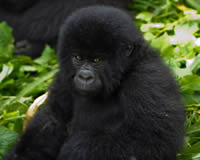Since time immemorial, various people have had varying dimensions as far as the calmness and kindness of gorillas is concerned. This has been majorly brought into limelight by the famous king Kong gorilla that was seen in a movie fiercely fighting off planes and pulling them down atop the Empire State Building and this keeps on twinkling down to all human beings psyche that gorillas are menacing and very hostile creatures. But in actual sense gorillas can be gentle, almost human-like creatures and are only a threat if you provoke them. With that said, here comes the million dollar question: How safe is a Rwanda gorilla trek since it involves humans invading gorillas’ habitats in the African rainforest?
Gorilla tourism with a focus on preservation started in the 1950s by German traveler Walter in Uganda and became quite popular for travelers in the 1960s. Fast forward to recent years and gorilla trekking is still a much desired activity to do in the eastern central African region — in fact, for some it is the primary reason to journey there.
Official gorilla tour guides lead small groups on foot, in one of the national parks were gorillas make their habitat, and follow clues to pinpoint their exact location. There’s hiking and scrambling and some climbing involved, so it requires being somewhat in shape, especially since it could take anywhere between half an hour to eight hours before a family of gorillas is actually found. Once the encounter is made, you are given about an hour to marvel in their presence. The time you have with gorilla is in fact, safe — provided you follow certain rules
Speak quietly.
Don’t make any sudden movements; they can be interpreted as a provoking threat.
Take photos, but don’t use a flash.
If a gorilla starts charging, you don’t run away; simply crotch down in a visually apologetic way, until it cools down.
However, very many people hold the belief that gorilla trekking is an exhilarating, albeit relatively expensive activity to do in the African region — but people have justified the high cost as a once-in-a-lifetime experience. Gorilla trekking permits range from $400-$750 USD for only one day (depending on what country), and that doesn’t necessarily include the transportation, food, accommodation or the guide. However, the prices are justified as the money goes towards the preservation of the species and the rainforest they live in. This is a beneficial thing because there are only about 700 wild mountain gorillas left in the planet. Their population has been decimated over the years by their biggest threat- humans, who ironically share 97 percent of their DNA. Poaching has been a big problem in the region for decades; gorilla adults are beheaded for accessories and babies are kidnapped and sold to zoos. It also leads to other violence; Dian Fossey, who famously journeyed to Rwanda to study and preserve gorillas from the 1960s through the 80s, was murdered in a probable response to her anti-poaching stance.
But what about safety from guerrillas?
To a mountain gorilla, there are no political boundaries; the concentration of their species lies in a section of rainforest that encompasses Rwanda, Uganda, and the Democratic Republic of Congo. War broke out in Uganda in the 1970s and 80s, and the 90s was when the historically tragic genocide of Rwanda took place. There are constant reports of violence and turmoil from militant guerrillas (the other kind) in the Democratic Republic of Congo — in fact, the United Nations just called it “the rape capitol of the world.” With that said, you might wonder: Okay, so gorilla trekking is generally safe, but how safe is it to go to the countries where gorilla trekking takes place?
Uganda started rebuilding their war torn country in the late 1980s and 90s, and has since rebuilt their society to be a lively, peace-keeping one. Meanwhile, neighboring Rwanda had their share of war during the same era, also to rebuild their country later and ultimately become what some believe to be a model country of Africa. Both Uganda and Rwanda have been through decades of violence, but have each developed peaceful national psyches that oppose any conflict. They both have built national parks around gorilla habitats to preserve their environment — Bwindi Impenetrable National Park in Uganda and Parc National des Volcans in Rwanda.
To conclude, yes gorilla trekking is safe if you follow the rules and safest in Rwanda or Uganda


Comments